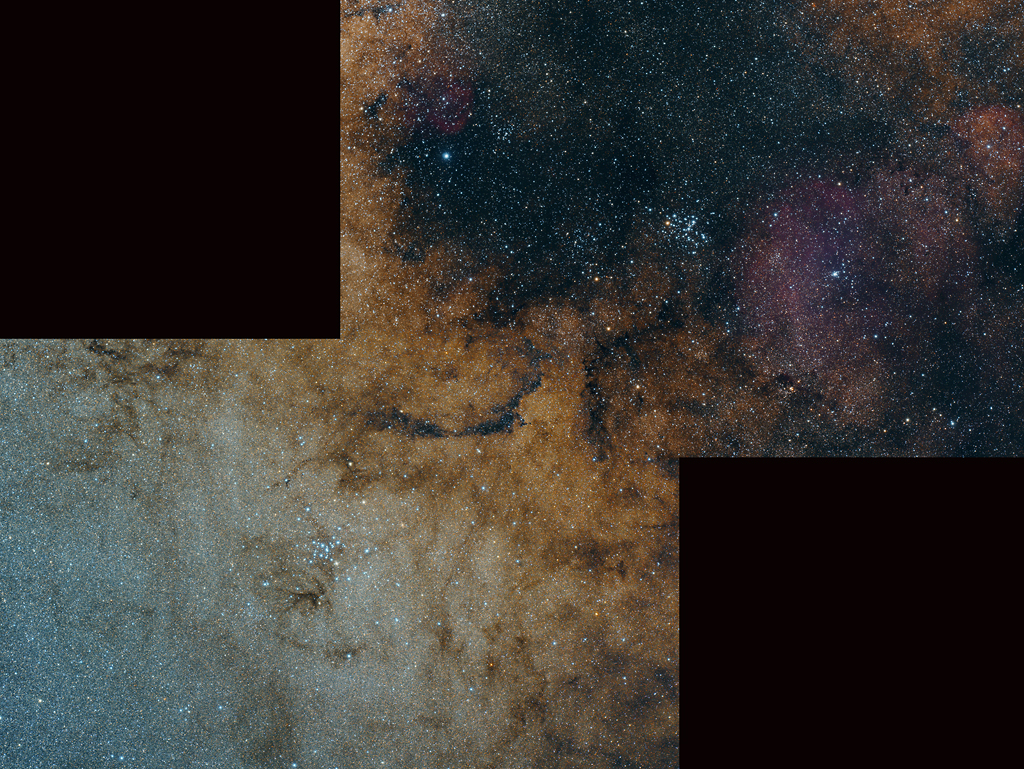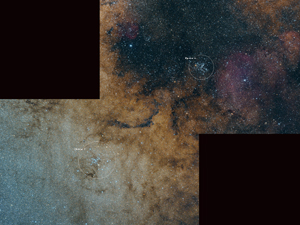 |
CHAMÄLEON + ONJALA OBSERVATORY DeepSky | SITEMAP HOME CHAMÄLEON |
|
 |
|||
| « zurück zur Startseite
Sternhaufen « back to home star cluster |
Großes Bild laden - load large image 2048 x
1400 Pixel Aufnahmedaten Image data |
The two large open star clusters Messier 6 and Messier 7 in a mosaic of 4

Der 95 Millionen Jahre alte offene Sternhaufen Messier 6 (auch Schmetterlingsnebel genannt) befindet im Sternbild Skorpion und ist rund 1600 Lichtjahre von der Erde entfernt. Mit einem scheinbaren Durchmesser von 25 Bogenminuten ist der Sternhaufen am Himmel etwa so groß wie der Mond wie mit dem bloßen Auge betrachtet. Daraus folgt ein wahrer Durchmesser von ca. 12 Lichtjahre. Der Haufen beinhaltet etwa 100 Sterne, er wird nach Trumpler der Klasse II 3 r zugeordnet.
Messier 6 wurde in der Zeit um 1654 von dem italienischen Astronomen Giovanni Battista Hodierna entdeckt. Es wird vermutet, dass bereits Claudius Ptolemäus den Sternhaufen bei seinen Beobachtungen von Messier 7 gesehen haben könnte, was jedoch nicht gesichert.
Der offene Sternhaufen Messier 7 befindet sich vor dem extrem sternreichen Hintergrund der Milchstraße im östlichen Teil des Sternbildes Skorpion. Die Entfernung zu M 7 beträgt etwa 8000 Lichtjahre, das Alter der Sterne von M 7 wird auf 200 Millionen Jahre geschätzt. Er beinhaltet etwa 100 Sterne und nach Trumpler wird er der Klasse I 3 m zugeordnet.
Im Jahr 130 erwähnte der Mathematiker und Astronomen Claudius Ptolemäus diesen Sternhaufen als erster, weshalb er auch den Namen "Ptolemaeus Sternhaufen" trägt.
Object description
The 95-million-year-old open star cluster Messier 6 (also known as the butterfley cluster) is located in the constellation Scorpio and is about 1600 light-years away from Earth. With an apparent diameter of 25 arc minutes, the star cluster is about as large in the sky as the moon as seen with the naked eye. This gives it a true diameter of about 12 light years. The cluster contains about 100 stars, it is assigned to class II 3 r according to Trumpler.
Messier 6 was discovered around 1654 by the Italian astronomer Giovanni Battista Hodierna. It is assumed that Claudius Ptolemy may have already seen the star cluster during his observations of Messier 7, but this is not certain.
 |
The open star cluster Messier 7 is
located in front of the extremely star-rich background of the Milky Way in the
eastern part of the constellation Scorpio. The distance to M 7 is about 8000
light years, the age of the stars of M 7 is estimated to be 200 million years.
It contains about 100 stars and according to Trumpler it is classified as
class I 3 m. In the year 130, the mathematician and astronomer Claudius Ptolemy was the first to mention this star cluster, which is why it is also called the "Ptolemy Star Cluster". « Hier oder auf das Vorschaubild zum Laden eines großen Bildes mit Objektbezeichnungen klicken. « Click here or on the thumbnail to load a large image with object annotations. |
Messier 6 and Messier 7 in a widefield view
Image data
30./31.05. + some nights in June 2022 - 48 x 300 s, ZWO ASI 071 MC Pro
Telescope: RedCat 51 APO 250 mm f/4,9 Flatfield
Location: Chamäleon Observatory, Onjala Lodge, Namibia
Image acquisition and processing: DeepSkyStacker, Pixinsight and Photoshop by Bernd Gooßmann
 |
 |
 |
 |
 |
 |
 |
| Sonne | Mond | Sonnensystem | DeepSky | Weitwinkel | Verschiedenes | Spez. Projekte |